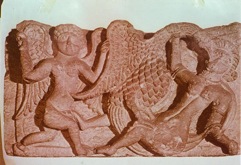HISTORY OF THE COPTIC MUSEUM
French version >>Interest in Coptic art was revived at the end of the 19th century when Mr. Gaston Maspero, a French Egyptologist, brought together many pieces in dedicated rooms of the Egyptian museum.

In 1939, the Service of Antiquities decided to transfer the totality of the Christian Antiquities exhibited in the Egyptian Museum to the Coptic Museum. Since then, all findings originating in Christian sites have automatically gone to the Coptic Museum.
You will find funerary stelae (2nd-5th century) from Kom Abou Billou whose style and iconography mark the transition between religious Pharaonic art (Horus falcon, Anubis jackal) and Coptic art (orant with arms raised, crosses, birds) symbolising the hoped for resurrection.
The Museum’s founder wished to bring together all the material necessary to study Christian history in Egypt. Thanks to his enthusiasm for Coptic antiquity, he succeeded in his project to create this Museum which links Pharaonic, Greco-Roman and Islamic antiquity. The Museum is located within the walls of the fortress of Babylon, part of the old city walls built by Emperor Trajan in 98 A.D., which also houses the old churches of Cairo: St. Sergius and St. Barbara of the 4th century and the Hanging Church “El Muallaqa” of the 6th century.
The Museum occupies an area of 8,000m2, buildings and garden included. Ever since the founder initiated the project, the Coptic community has been active in filling it with precious and rare pieces. Members of the community have sent icons, cloths, manuscripts, priestly garments, frescoes, and wooden panels. Painted wooden ceilings and marble fountains were collected from old Coptic palaces.

From the 6th century onwards, reliefs inspired by scripture multiply: the three Hebrews in the furnace, the Virgin nursing the Infant Jesus, angels holding aloft a medallion displaying a bust of Christ, St. George and other saints on horseback.
A majestic ambon, known as “Jeremiah’s Pulpit”, dates from the same period, this time from the Monastery of St. Jeremiah in Saqqara.

The examples of woodwork confirm the particular mastery of the Copts in working this warm and vibrant medium: doors and iconostatic screens, panels showing episodes from the life of Christ, liturgical objects, altars, crosses and lecterns.
There is a wealth of cloths which highlight a wide diversity of techniques and materials. They cover Biblical subjects as well as scenes from daily life.

President Hosni Mubarak has taken a strong interest in the Coptic Museum and came in person to inaugurate it on 26th June 2006, along with a hundred leading personalities.
The Museum holds a collection of 16,000 works of art, of which 1,200 real treasures are exhibited to the public. It owns 6,000 papyrus manuscripts of which the most important are the Psalms of David and the manuscripts of Nag Hammadi.
Isis Zaki
Translated by Rachel James
Photo courtesy of Isis Zaki